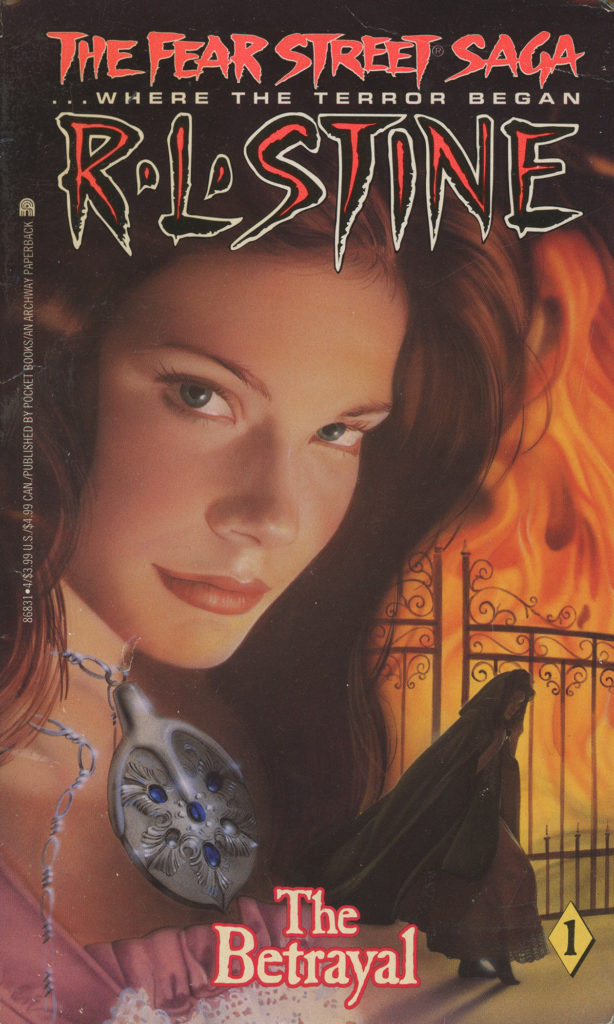 Fear Street Saga The Betrayal Book Cover
Fear Street Saga The Betrayal Book Cover
Spoiler-Free Dive into Shadyside’s Dark History
R.L. Stine’s Fear Street Saga marks a significant evolution within the Fear Street universe, enriching the town of Shadyside with a deep, historical backdrop previously unexplored. By transporting readers to colonial America, Stine crafts a narrative in The Betrayal that feels both fresh and rooted in the franchise’s signature horror. What sets this book apart, even years after its initial release, is its surprisingly stark depiction of violence, a bold move that resonates even with adult readers revisiting these tales. Stine masterfully taps into the grim realities of life three centuries ago, amplifying the inherent horror of witch trials and the shadowy allure of dark magic. While the narrative drive is compelling, a slight drawback lies in the portrayal of female characters, who often seem relegated to reactive roles, primarily defined by romantic interests and vulnerability to malevolent forces. This, however, doesn’t derail the story’s momentum but hints at untapped potential for deeper character development. Overall, The Betrayal serves as a potent opening chapter, establishing a high benchmark for the trilogy and demonstrating why the Stine Fear Street series continues to captivate audiences.
Score: 4.5/5
Unraveling the Secrets: Plot Points and Spoilers Lurk Below
The Betrayal commences in 1900, amidst the fiery destruction of Fear Mansion, a notorious landmark in Shadyside. Nora Goode, the fire’s sole survivor, clutches a pendant—a relic from Daniel Fear, prominently featured on the book’s cover—and embarks on a mission to chronicle the intertwined and cursed histories of the Goode and Fear families. This opening, framing the narrative within the familiar setting of the fire-ravaged Fear mansion, effectively draws the reader into Shadyside’s long-standing lore. Nora’s narration, though occasionally repetitive, provides a structural backbone to the unfolding events, primarily set in 1692 Wickham Village, a fledgling Puritan settlement.
Here, Susannah Goode finds herself entangled in a forbidden romance with Edward Fier, son of the town magistrate. Benjamin Fier, Edward’s father, upon discovering their affection, abuses his authority to fabricate evidence, accusing Susannah and her mother of witchcraft. Benjamin’s brother, Matthew, presides over a sham trial, sealing the women’s fate. In a departure from typical witch trial outcomes of hanging, Benjamin demands they be burned at the stake. William Goode, Susannah’s father, desperately attempts to negotiate with Matthew Fier to save his family. Matthew, wearing the same pendant Nora possesses in the prologue, agrees to drop the charges in exchange for William’s entire fortune.
William complies, surrendering all his possessions. The following morning, he arrives to witness his wife and daughter’s exoneration, only to discover the Fiers have absconded overnight, having plundered Wickham’s resources. Despite the Fiers’ exposure as frauds, the town warden inexplicably proceeds with the sentencing, and Susannah and her mother are tragically burned. William Goode, now desolate with only his infant son George, retreats to his home. There, he accesses a hidden chamber, revealing his secret identity as a practitioner of dark magic—his family, in stark contrast, were innocent victims. Fueled by grief and rage, William unleashes his powers, laying a potent curse upon the Fier lineage.
Several narrative threads here warrant closer examination. Why did William Goode not employ his magical abilities to avert the burning initially? While the text doesn’t explicitly provide an answer, it arguably serves to amplify the dramatic reveal of William’s magical nature later in the story. Furthermore, the Fiers’ sudden departure raises questions. While their fraudulent nature is evident, there’s no clear indication they were on the verge of exposure. Their flight, therefore, seems somewhat disconnected from Benjamin’s motivation to frame Susannah and her mother. If their intention was to abandon Wickham regardless, the elaborate witch trial plot appears unnecessarily convoluted. Finally, the warden’s insistence on carrying out the burnings despite the Fiers’ revealed treachery feels jarring. One would expect at least some challenge to the proceedings, given the loss of credibility of Benjamin Fier’s accusations. Perhaps this reflects a commentary on rigid, unyielding systems of justice, impervious to reason or change.
The narrative then leaps forward eighteen years to the Pennsylvania frontier. Edward Fier is now married to the discontented Rebecca, and they have a young son named Ezra. Benjamin Fier, aged but still domineering, remains at the family’s helm. Matthew Fier has married Constance, and their teenage daughter, Mary, enters the scene. The Fier family has achieved prosperity on their farm, enjoying a period of relative calm. However, this tranquility is shattered when William Goode, driven by vengeance, finally locates them.
Edward suffers an injury, falling from a roof. A young man named Jeremy, seeking employment to support his elderly father, arrives at the farm and is hired. Mary and Jeremy quickly become romantically involved, engaging in clandestine rendezvous. Both Mary and Edward experience unsettling visions of fire in the woods, with Edward recognizing Susannah amidst the flames – a clear sign of the curse’s activation. Events rapidly descend into horror. Edward’s wife, Rebecca, commits suicide by hanging in front of Ezra, and Benjamin is discovered crucified in the fields, posed as a scarecrow. Following these grim funerals, George reveals himself to Mary as George Goode, confessing his father’s curse upon her family. He claims the only way to break the curse is through their marriage.
Mary and Edward confront Matthew about the injustices inflicted upon the Goode family in Wickham. Matthew confesses his culpability, granting his blessing to Mary’s proposed marriage to George, and invites Jeremy (unaware of his true identity) for dinner. During the dinner, Matthew, wielding his pendant, unleashes a curse that causes Jeremy’s head to explode, revealing Jeremy’s true form – William Goode, magically disguised as a young man. Matthew then uses the pendant again to kill William, succumbing to maniacal laughter as Constance pleads for him to stop. Edward, Mary, and Ezra flee the house, leaving Matthew consumed by his descent into madness.
Fifteen years later, Ezra, now an adult, returns to the abandoned Fier estate. His father died from overwork, his Aunt Mary drowned, and Ezra is penniless. Within the derelict house, he discovers the skeletal remains of Matthew and Constance walled up in the study. Matthew’s journal reveals he had sealed himself within the study to escape the curse, killing Constance when she attempted to leave. Ezra retrieves the Fier family pendant, vowing revenge against the Goodes for his family’s destruction, setting the stage for further conflict in the Stine Fear Street saga.
The narrative does fall into some familiar tropes, particularly with Susanna and Mary’s storylines revolving around unrequited love. While teenage romance is a common theme, it would have enriched the narrative to see these female characters exhibit greater agency beyond their romantic entanglements. Given the patriarchal societal context of the time period (and arguably, the prevalent gender dynamics of the 1990s publishing era), their reactive roles are somewhat understandable. However, it does represent a missed opportunity for more empowered female characters within the Stine Fear Street narrative. Despite this, the curse itself acts as a powerful external force, driving the plot and somewhat mitigating the limitations placed on the female characters’ control over their destinies. This doesn’t detract significantly from the story’s impact but remains a point of potential improvement.
Ultimately, The Betrayal stands out as arguably the most lethal installment in the Fear Street series to date, with a staggering body count of nine deaths. True to Fear Street conventions, most of these deaths occur off-screen, minimizing explicit gore. This restraint, rather than detracting from the horror, arguably amplifies the impact of the violent moments that are depicted, preventing them from becoming desensitizing. Stine’s skillful navigation of these boundaries contributes to the book’s chilling atmosphere and its reputation as a standout title within the series.
Score Card Breakdown
To evaluate each book, a five-criterion scoring system is used, with each criterion worth a maximum of 2 points, contributing to a total score out of 5 stars. The criteria are:
Concept: The strength and originality of the overarching idea.
Execution: The effectiveness of the storytelling mechanics.
Character: The depth and development of protagonists, antagonists, and villains.
Intent: The success in achieving the book’s intended genre and tone.
Originality: The level of subversion and innovative use of genre conventions.
Concept: 2/2 – The foundational concept of delving into the Fear family’s origins and providing historical context for Fear Street is exceptionally strong.
Execution: 2/2 – Opening with the Fear Mansion fire is a masterstroke, grounding the narrative in established Fear Street lore. The pacing is well-managed, balancing suspense with impactful moments of horror, and effectively sets up the subsequent books in the saga.
Character: 1/2 – While male characters are richly developed and complex, Susannah and Mary lack depth beyond their romantic pursuits, representing a missed opportunity for more nuanced female character portrayals.
Intent: 2/2 – The book successfully delivers on its horror premise with a high body count and disturbing scenarios, amplified by the effective use of the historical setting to enhance the sense of dread.
Originality: 2/2 – The Betrayal distinguishes itself from the main Fear Street series by adopting a historical saga format, successfully expanding the Fear Street mythology while maintaining its core creepiness.
According to GoodReads aggregate ratings, The Betrayal holds a high rank: 2nd out of 79 books in the entire Fear Street series and 2nd out of 6 trilogies within The Fear Street Saga collection.
Don’t miss the next chapter in our Fear Street exploration: Fear Street Saga #2: The Secret
Explore more spine-tingling tales in our Pulp Horror series: R.L. Stine’s The Babysitter
Fair Use Notice

